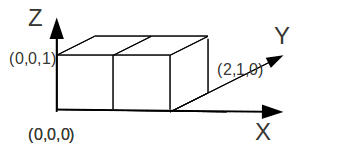4. D modeling#
4.1. Geometry and modeling#

The mesh is composed of:
1 HEXA8sur mesh to which the 3D modeling is affected.
1 HEXA20sur mesh to which we assign the 3D modeling_ INTERFACE.
HEXA1 |
3D |
HEXA2 |
3D_ INTERFACE |
4.2. Orientation of the local coordinate system#
In order to define the local coordinate system for these elements, the keyword factor MASSIF from the AFFE_CARA_ELEM operator is used (see U4.42.01).
Several ways of defining a local coordinate system are proposed, here we are testing ANGL_REP and the ANGL_AXE/ORIG_AXE couple.
The table above gives the orientations chosen for each element:
HEXA1 |
|
|
HEXA2 |
|
|
4.3. Calculating local landmarks#
The local landmarks are formed by the vectors \(x\), \(y\), and \(z\).
The values given in ANGL_REP define the following guidelines:
\(x=\left(\mathrm{0.5,0}\mathrm{.5,}-\frac{\sqrt{2}}{2}\right)\), \(y=\left(\mathrm{0.5,0}\mathrm{.5,}\frac{\sqrt{2}}{2}\right)\), and \(z=\left(\frac{\sqrt{2}}{2},-\frac{\sqrt{2}}{2},0\right)\).
The ANGL_AXE/ORIG_AXE pair is used in the case of a model with cylindrical geometry. They define an axis \({e}_{z}\) being the axis of the cylindrical coordinate system.
\(x\) corresponds to the vector \({e}_{z}\) of this cylindrical coordinate system, the reference point being the barycenter of the cell here \((1.5\mathrm{,0}.5\mathrm{,0}.5)\). \(y\) corresponds to the vector \(\mathrm{-}{e}_{\theta }\) and \(z\) to the vector \({e}_{r}\).
In this example \(x=\left(\frac{\sqrt{2}}{2},\mathrm{0,}\frac{\sqrt{2}}{2}\right)\), \(y\mathrm{=}(\mathrm{0,1}\mathrm{,0})\), and \(z=\left(\frac{-\sqrt{2}}{2},\mathrm{0,}\frac{\sqrt{2}}{2}\right)\).
4.4. Tested sizes#
The tested results are shown in the following table:
MAILLE |
Vector |
Component |
Reference Value |
Tolerance |
|
HEXA1 |
|
|
|
|
|
HEXA1 |
|
|
|
|
|
HEXA1 |
|
|
|
|
|
HEXA2 |
|
|
|
|
|
HEXA2 |
|
|
|
|
|
HEXA2 |
|
|
|
|
|
HEXA1 |
|
|
|
|
|
HEXA1 |
|
|
|
|
|
HEXA1 |
|
|
|
|
|
HEXA2 |
|
|
|
|
|
HEXA2 |
|
|
|
|
|
HEXA2 |
|
|
|
|
|
HEXA2 |
|
|
|
|